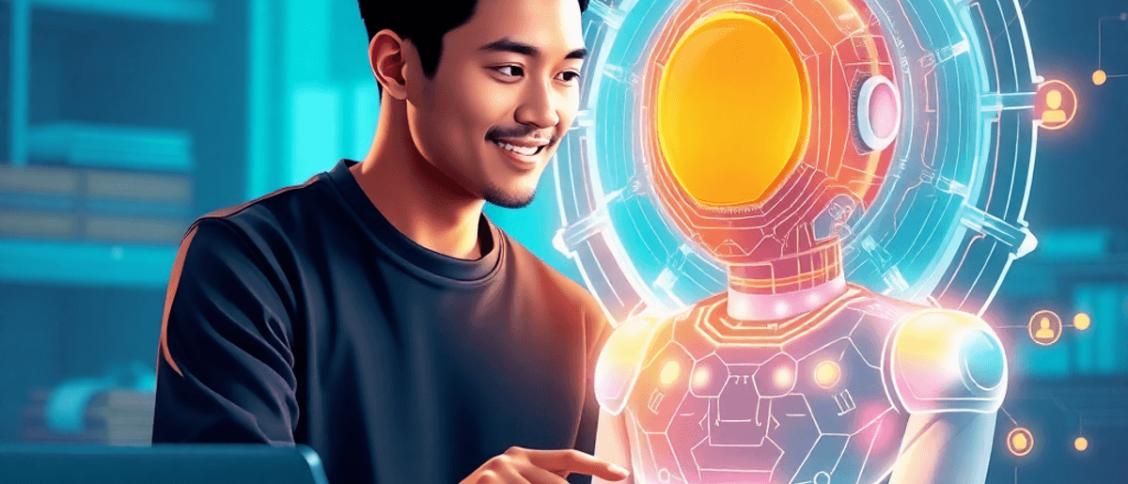Introduction
“Co-Intelligence” by Ethan Mollick explores the ever-changing relationship between humans and artificial intelligence (AI). Mollick, an expert in innovation and entrepreneurship, offers a thoughtful examination suitable for a broad audience, including those unfamiliar with AI concepts.
The main message of Co-Intelligence is clear: Co-Intelligence represents the future of human-AI collaboration. As we navigate this rapidly evolving landscape, understanding how to work alongside intelligent systems will be crucial for success in both personal and professional spheres.
Understanding Co-Intelligence
Co-Intelligence, as defined by Ethan Mollick, refers to the dynamic relationship where humans and artificial intelligence (AI) collaborate to enhance decision-making, creativity, and problem-solving. This concept emphasizes the synergy created when human intuition and emotional intelligence merge with AI’s ability to process vast amounts of data quickly.
Collaborative Intelligence
The idea of collaborative intelligence goes beyond simply using AI as a tool. It envisions a future where AI acts as a partner, enhancing our capabilities while we retain control over creative and strategic decisions. Unlike traditional models of intelligence that often measure individual performance in isolation, Co-Intelligence recognizes the value of working together—humans leveraging their unique strengths alongside AI’s computational power.
Differences from Traditional Intelligence Models
Traditional intelligence models typically focus on the individual or isolated systems of thought. They prioritize human cognitive abilities, often ignoring how technology can complement these skills. Co-Intelligence shifts this perspective by:
- Emphasizing teamwork: It advocates for a collaborative approach where human-AI partnerships drive innovation.
- Fostering adaptability: As AI evolves, so too must our ways of thinking and working, leading to more flexible strategies.
- Encouraging inclusivity: Co-Intelligence opens doors for diverse teams that harness various skills—both human and machine—to tackle complex challenges.
By understanding Co-Intelligence, individuals can better prepare themselves for an integrated future where machines are not just tools but essential partners in progress. The implications stretch across industries, making it crucial to grasp how this collaboration will redefine work dynamics and creativity in the years ahead.
The Role of AI as a Collaborative Partner
The concept of AI as a collaborator is gaining traction across various fields, marking a shift in how we perceive our relationship with technology. Successful individuals are increasingly embracing AI as partners, transforming the workplace landscape. This partnership enhances creativity and productivity, allowing professionals to focus on higher-level tasks while AI handles repetitive or data-intensive responsibilities.
Real-World Applications of AI in Collaboration
AI’s role as a collaborative partner manifests in several industries, enabling enhanced brainstorming and decision-making processes. Here are some key areas where AI demonstrates its potential:
1. Marketing
- Drafting Campaign Ideas: Marketers are utilizing AI tools to generate innovative campaign concepts based on past performance data and market trends. These systems analyze vast amounts of information, providing insights that help teams craft more targeted strategies.
- Predicting Customer Preferences: AI algorithms can predict consumer behavior by analyzing browsing history and purchase patterns. This allows businesses to tailor their marketing efforts effectively, optimizing resource use while engaging customers meaningfully.
2. Education
- Personalized Learning Experiences: In educational settings, AI technologies create customized learning pathways for students. By assessing individual strengths and weaknesses, AI can recommend resources and exercises that cater specifically to each learner’s needs.
- Tutoring and Support: Intelligent tutoring systems provide real-time feedback and support, helping students grasp complex concepts at their own pace while freeing educators to focus on group instruction.
3. Healthcare
- Analyzing Complex Genetic Data: In the realm of healthcare, AI is revolutionizing how medical professionals interpret genetic information. By sifting through large datasets quickly, AI can identify patterns that may indicate predispositions to certain conditions, enabling proactive treatment plans.
- Assisting Diagnostics: Machine learning algorithms assist doctors by analyzing medical images or lab results to identify abnormalities with higher accuracy than traditional methods. This leads to faster diagnoses and improved patient outcomes.
Case Studies in Different Industries
Several case studies illustrate the effectiveness of human-AI partnerships across diverse sectors:
- Marketing Innovations: A leading advertising agency implemented an AI-driven platform that generates creative content suggestions for social media campaigns based on audience response data. This led to a significant increase in engagement rates and reduced time spent on brainstorming sessions.
- Transformative Education: A school district integrated an AI-powered learning management system that adapts curriculum materials based on real-time student assessments. Educators noted improved student performance and greater engagement levels among learners who previously struggled with standardized teaching methods.
- Healthcare Advancements: A major hospital network adopted an AI system for analyzing patient records and predicting potential health risks. As a result, healthcare providers could intervene earlier in at-risk patients’ care plans, enhancing preventive measures and overall health outcomes.
These examples highlight the significant impact of Co-Intelligence as outlined by Ethan Mollick in his book “Co-Intelligence.” The collaboration between humans and AI paves the way for innovative solutions across various fields, allowing professionals to leverage technology not just as a tool but as an integral team member.
As organizations continue exploring these partnerships, understanding the nuances of working alongside intelligent systems will be crucial for maximizing potential benefits while navigating challenges ahead.
Enhancing Productivity Through AI-Powered Workflows
Automation with AI plays a crucial role in transforming productivity across various industries. By taking over repetitive tasks, intelligent systems allow professionals to focus on more meaningful and creative work. This shift not only enhances job satisfaction but also drives innovation.
Key Aspects of Productivity Transformation
1. Automation of Repetitive Tasks
AI excels at handling mundane tasks that can consume valuable time. This includes data entry, scheduling, and even basic customer service through chatbots. For example, companies like IBM use AI to streamline their HR processes, freeing up human resources teams to concentrate on strategic initiatives rather than administrative duties.
2. Focusing on Meaningful Work
With AI managing routine activities, employees are empowered to engage in more impactful projects. This transition fosters a culture of creativity and critical thinking. Organizations like Unilever have reported improved employee morale and increased innovation as teams dedicate their efforts to complex problem-solving.
Successful Workflow Transformations
Several industries are reaping the benefits of AI-driven workflows:
- Marketing: Brands utilize AI tools for campaign analysis and customer behavior predictions, leading to more effective marketing strategies. For instance, Netflix employs AI algorithms to analyze viewer preferences, which helps them tailor content recommendations.
- Education: Adaptive learning platforms leverage AI to create personalized educational experiences. Companies like Coursera implement these technologies to assess student performance and suggest tailored courses, ensuring learners receive the support they need.
- Healthcare: Healthcare providers harness AI for analyzing vast amounts of patient data. Systems like IBM Watson assist doctors in diagnosing diseases by identifying patterns within genetic information rapidly.
These examples illustrate how automation with AI is reshaping workflows, enabling organizations to enhance productivity while allowing employees to channel their efforts into more significant contributions. Embracing this technology paves the way for a future where humans and machines collaborate harmoniously.
Developing Skills for the Future Workforce
The rapid advancement of AI technologies creates a pressing need for professionals across all sectors to enhance their understanding of these tools. AI literacy has become a crucial component in the modern workplace, enabling individuals to navigate and utilize AI effectively. This knowledge empowers employees not only to engage with AI systems but also to make informed decisions about their applications.
Key aspects of developing AI literacy include:
- Understanding AI Basics: Familiarity with fundamental concepts such as machine learning, natural language processing, and data analytics. This foundational knowledge helps demystify AI functions and promotes confidence in its use.
- Application in Real-world Scenarios: Gaining insights into how various industries leverage AI can inspire innovative thinking. For instance, marketing professionals might explore predictive analytics to tailor campaigns, while educators can utilize adaptive learning platforms to personalize student experiences.
Training programs play a pivotal role in equipping the workforce with necessary skills. These initiatives should focus on:
- Hands-on Learning Experiences: Engaging workshops and simulations that allow participants to interact with AI tools directly. Practical experience fosters a deeper understanding and enhances problem-solving abilities.
- Continuous Skill Development: In an era characterized by rapid change, professionals must cultivate adaptive learning skills. This involves not just acquiring knowledge but also being willing to adapt and learn as technology evolves.
Organizations that invest in training their employees can create a more competent workforce that embraces intelligent systems. By prioritizing AI literacy and fostering adaptive learning, companies ensure they remain competitive in an increasingly automated landscape.
Building a culture of innovation and continuous improvement prepares individuals for the future work environment where collaboration with intelligent systems will be standard practice.
Ethical Considerations in Co-Intelligence
The integration of AI into various sectors raises significant ethical concerns that cannot be overlooked. As highlighted in “Co-Intelligence” by Ethan Mollick, understanding these implications is crucial for responsible AI use. Key areas of concern include:
1. Bias in AI Systems
AI algorithms can inadvertently perpetuate existing biases present in training data. In fields like education and healthcare, this could lead to unfair treatment of certain groups. For instance, a biased algorithm might disadvantage minority students in educational assessments or misdiagnose health conditions based on skewed data.
2. Transparency and Accountability
With AI making decisions affecting human lives, transparency becomes essential. Users should understand how AI systems arrive at their conclusions. Implementing clear guidelines for accountability ensures that organizations are responsible for the outcomes generated by their AI tools.
Strategies to promote ethical AI development include:
- Diverse Training Data: Ensuring that datasets used to train AI models are diverse can help mitigate bias. This approach fosters fairness and inclusivity, allowing the technology to serve a broader population effectively.
- Regular Audits: Conducting periodic audits of AI systems helps identify and rectify biases or inaccuracies promptly. Continuous monitoring ensures that the AI evolves alongside societal norms and values.
- Stakeholder Engagement: Involving various stakeholders, including ethicists, community representatives, and end-users, during the development process fosters a more comprehensive understanding of potential impacts. Their insights can guide ethical considerations from multiple perspectives.
- Education on Ethical Use: Promoting awareness about ethical considerations among developers and users aids in creating a culture of responsibility surrounding AI technologies.
As organizations continue to embrace co-intelligence, prioritizing ethical practices will shape a future where human-AI collaboration thrives while respecting individual rights and societal standards.
The Impact of Co-Intelligence on Creativity
Co-Intelligence represents a transformative approach to creativity, emphasizing that the collaboration between humans and AI can enhance, rather than diminish, creative processes.
1. Boosting Human Creativity
By working alongside AI tools, individuals can unlock new avenues of inspiration. AI can analyze vast datasets, identify patterns, and generate ideas that might not be immediately apparent to human creators. This partnership allows for brainstorming sessions where AI offers diverse options, enabling artists, writers, and designers to expand their creative horizons.
2. Human Touch Matters
While machine-generated content can offer efficiency and volume, it often lacks the emotional depth and nuanced understanding inherent to human expression. For instance, a novel or artwork created entirely by an algorithm may follow technical guidelines but may miss the heartfelt connection that resonates with audiences. Human storytellers infuse personal experiences and emotions into their work, creating a profound impact on viewers or readers.
The limitations of machine creativity become evident when considering the subtleties of artistic expression. AI lacks the lived experiences that inspire authentic emotion; it cannot fully grasp cultural contexts or societal nuances in the same way a human can.
In practical terms:
- AI as a Creative Assistant: Tools like generative art software or language models can serve as collaborators rather than replacements. Writers might use AI to draft outlines or suggest plot twists but will ultimately refine the narrative through their unique voice and perspective.
- Emotional Resonance: Successful creative endeavors often hinge on connecting with an audience’s feelings. While AI can generate text or music, it requires human input to ensure that these creations evoke genuine emotions.
This harmonious interaction between human ingenuity and AI capabilities leads to a richer creative landscape where both parties thrive together. The future promises exciting possibilities as we continue to explore this dynamic partnership.
Overcoming Barriers to Adoption
Embracing AI tools within organizations requires a significant shift in mindset. This transformation is essential for harnessing the full potential of these technologies. Here are key strategies to facilitate this change:
1. Encourage Openness
Organizations should foster an environment where employees feel comfortable expressing concerns and curiosities about AI. Open dialogue can demystify AI technologies and build trust.
2. Promote Collaboration
Encourage teams to collaborate with AI rather than view it as a competitor. This partnership mindset allows employees to see AI as a valuable asset that can enhance their work.
3. Invest in Training
Providing training programs tailored for different skill levels empowers employees to understand and effectively use AI tools. Continuous education not only builds competence but also confidence in utilizing these technologies.
Building a culture centered on continuous learning, adaptation, and responsible use of technology is crucial. Consider these aspects:
1. Lifelong Learning Initiatives
Organizations can implement workshops, seminars, and online courses to keep skills updated. Employees who engage in ongoing learning are more likely to adapt to new tools and processes seamlessly.
2. Feedback Mechanisms
Establishing channels for feedback on AI tools helps organizations refine their use and address any issues swiftly. Employees should feel their input is valued in shaping how AI can be integrated into workflows.
3. Integrate Ethical Considerations
As organizations adapt to new technologies, they must also prioritize ethical implications. Encouraging discussions around fairness, transparency, and accountability ensures that the deployment of AI aligns with organizational values.
These approaches not only mitigate fears surrounding job displacement but also empower individuals within the organization to embrace transformational tools confidently. The future of work will increasingly rely on harmonious collaboration between humans and machines, making these shifts vital for success in an AI-driven landscape.
Overcoming Barriers to Adoption
The transition to an AI-driven future often brings with it a fear barrier that can hinder progress. Employees may worry about job displacement and the implications of working alongside intelligent systems. This fear can create resistance to adopting new technologies, making it essential to address these concerns thoughtfully.
Addressing Job Displacement Fears
Companies should consider the following actions to address employees’ fears regarding job displacement:
- Open Dialogue: Foster an environment where employees feel safe discussing their fears regarding AI. Open lines of communication can help dispel myths and provide clarity on how AI will be integrated into workflows.
- Education and Training: Provide training programs that help employees develop skills that complement AI technologies. Understanding how to work alongside AI can empower individuals, easing anxiety about job loss.
The Role of Leadership in Fostering Trust
Leadership plays a pivotal role in navigating the transition toward Co-Intelligence. Here are key strategies leaders can employ:
- Transparent Communication: Communicate the vision for AI integration clearly. Transparency about how AI will enhance roles rather than replace them fosters trust.
- Promoting Collaboration: Encourage teamwork between human workers and AI systems demonstrates that these technologies are allies, not adversaries. Initiatives that highlight successful collaborations can inspire confidence among employees.
- Championing Continuous Learning: A culture focused on lifelong learning encourages employees to view changes as opportunities for growth rather than threats. Leaders should model this mindset by actively participating in training themselves.
Addressing fears around job displacement while reinforcing leadership’s commitment to collaboration is crucial for successful adoption of AI technologies. By fostering a supportive environment, organizations can transform apprehension into anticipation, turning challenges into opportunities for innovation and growth, as outlined in Co-Intelligence by Ethan Mollick.
Conclusion
The journey towards effective Co-Intelligence is filled with opportunities and challenges. Key elements shaping this landscape include:
- Continuous Learning: As AI evolves, professionals must remain engaged in lifelong learning. Staying informed about technological advancements helps individuals adapt seamlessly to new tools and practices.
- Adaptation: Embracing change is crucial. Workers need to develop a mindset that welcomes innovation, ensuring they can leverage AI as an ally rather than viewing it as a threat.
- Ethical Considerations: Navigating the ethical landscape of AI use is essential. Practicing fairness, accountability, and transparency in AI systems fosters trust and responsibility among users.
Ethan Mollick’s insights on Co-Intelligence highlight that the collaboration between humans and AI can lead to enhanced creativity, productivity, and innovation across various fields. As organizations begin to implement these concepts, they will not only improve their operational efficiency but also cultivate an environment that values human-AI partnerships.
The predictions for the future of Co-Intelligence suggest a dynamic shift in how we work together with technology. By focusing on these critical areas, society can create a balanced framework that maximizes the benefits of collaboration between humans and artificial intelligence.








